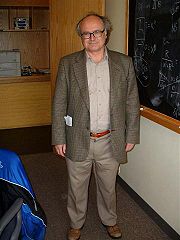
Gary Gibbons
Encyclopedia

Theoretical physics
Theoretical physics is a branch of physics which employs mathematical models and abstractions of physics to rationalize, explain and predict natural phenomena...
. Gibbons studied in Cambridge,
where in 1969 he became a research student under the supervision of Dennis Sciama
Dennis William Sciama
Dennis William Siahou Sciama FRS was a British physicist who, through his own work and that of his students, played a major role in developing British physics after the Second World War. He is considered as one of the fathers of modern cosmology.-Life:Sciama was born in Manchester, England...
. When Sciama moved to Oxford, he became a student of Stephen Hawking
Stephen Hawking
Stephen William Hawking, CH, CBE, FRS, FRSA is an English theoretical physicist and cosmologist, whose scientific books and public appearances have made him an academic celebrity...
, obtaining his PhD from Cambridge in 1973. Apart from a stay at the Max Planck Institute
Max Planck Society
The Max Planck Society for the Advancement of Science is a formally independent non-governmental and non-profit association of German research institutes publicly funded by the federal and the 16 state governments of Germany....
in Munich in the 1970s he has remained in Cambridge throughout his career, becoming a full professor in 1997, a Fellow of the Royal Society in 1999, and a Fellow of Trinity College, Cambridge
Trinity College, Cambridge
Trinity College is a constituent college of the University of Cambridge. Trinity has more members than any other college in Cambridge or Oxford, with around 700 undergraduates, 430 graduates, and over 170 Fellows...
in 2002.
Having worked on classical general relativity for his PhD thesis, Gibbons focused on the quantum theory of black holes afterwards. Together with Malcolm Perry
Malcolm Perry (physicist)
Malcolm John Perry, is a theoretical physicist. Perry is a professor of theoretical physics at the University of Cambridge. His research mainly concerns general relativity, supergravity and string theory....
, he used thermal Green's function
Green's function
In mathematics, a Green's function is a type of function used to solve inhomogeneous differential equations subject to specific initial conditions or boundary conditions...
s to prove the universality of thermodynamic properties of horizons, including cosmological event horizons. He developed the Euclidean approach
Euclidean quantum gravity
Euclidean quantum gravity refers to a Wick rotated version of quantum gravity, formulated as a quantum field theory. The manifolds that are used in this formulation are 4 dimensional Riemannian manifolds instead of pseudo Riemannian manifolds. It is also assumed that the manifolds are compact,...
to quantum gravity with Stephen Hawking
Stephen Hawking
Stephen William Hawking, CH, CBE, FRS, FRSA is an English theoretical physicist and cosmologist, whose scientific books and public appearances have made him an academic celebrity...
, which allows a derivation of the thermodynamics of black holes
Black hole thermodynamics
In physics, black hole thermodynamics is the area of study that seeks to reconcile the laws of thermodynamics with the existence of black hole event horizons...
from a functional integral approach. As the Euclid
Euclid
Euclid , fl. 300 BC, also known as Euclid of Alexandria, was a Greek mathematician, often referred to as the "Father of Geometry". He was active in Alexandria during the reign of Ptolemy I...
ean action for gravity is not positive definite, the integral only converges when a particular contour is used for conformal factors
Conformal map
In mathematics, a conformal map is a function which preserves angles. In the most common case the function is between domains in the complex plane.More formally, a map,...
.
His work in more recent years includes contributions to research on supergravity
Supergravity
In theoretical physics, supergravity is a field theory that combines the principles of supersymmetry and general relativity. Together, these imply that, in supergravity, the supersymmetry is a local symmetry...
, p-branes and M-theory
M-theory
In theoretical physics, M-theory is an extension of string theory in which 11 dimensions are identified. Because the dimensionality exceeds that of superstring theories in 10 dimensions, proponents believe that the 11-dimensional theory unites all five string theories...
, mainly motivated by string theory
String theory
String theory is an active research framework in particle physics that attempts to reconcile quantum mechanics and general relativity. It is a contender for a theory of everything , a manner of describing the known fundamental forces and matter in a mathematically complete system...
. Gibbons remains interested in geometrical problems of all sorts which have applications to physics.
Books
- Euclidean Quantum Gravity, World Scientific (Singapore, 1993); Paperback ISBN 9810205163
Related Pages
- Gibbons-Hawking-York boundary termGibbons-Hawking-York boundary termIn general relativity, the Gibbons–Hawking–York boundary term is a term that needs to be added to the Einstein-Hilbert action when the underlying spacetime manifold has a boundary....
- Euclidean quantum gravityEuclidean quantum gravityEuclidean quantum gravity refers to a Wick rotated version of quantum gravity, formulated as a quantum field theory. The manifolds that are used in this formulation are 4 dimensional Riemannian manifolds instead of pseudo Riemannian manifolds. It is also assumed that the manifolds are compact,...
- Gibbons-Hawking effectGibbons-Hawking effectThe Gibbons–Hawking effect is the statement that a temperature can be associated to each solution of the Einstein field equations that contains a causal horizon...

